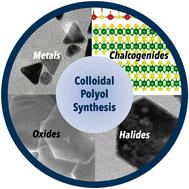当前位置:
X-MOL 学术
›
Dalton Trans.
›
论文详情
Our official English website, www.x-mol.net, welcomes your
feedback! (Note: you will need to create a separate account there.)
Colloidal synthesis of two-dimensional nanocrystals by the polyol route
Dalton Transactions ( IF 3.5 ) Pub Date : 2024-07-19 , DOI: 10.1039/d4dt01322k Tanner Q Kimberly 1 , Michelle H Frasch 1 , Susan M Kauzlarich 1
Dalton Transactions ( IF 3.5 ) Pub Date : 2024-07-19 , DOI: 10.1039/d4dt01322k Tanner Q Kimberly 1 , Michelle H Frasch 1 , Susan M Kauzlarich 1
Affiliation

|
The field of 2D nanomaterials is ever-growing with a myriad of synthetic advancements that have been used to obtain such materials. There are top-down, as well as bottom-up, fabrication methods for obtaining 2D nanomaterials; however, synthesis of 2D nanomaterials from solution offers a simple scalable way to control size, shape, and surface. This review outlines the recent advances in colloidal polyol synthesis of 2D nanomaterials and provides perspectives on the similarities and differences in various syntheses. Various materials classes are presented and discussed, including metals, oxides, chalcogenides, and halides, that can be synthesized as 2D nanomaterials via a polyol process. Throughout the literature, polyol media is demonstrated to be versatile not only as a solvent and reducing agent for metal precursors but also as a binding and shape-directing agent for many 2D nanomaterials. Polyols also offer the ability to dissolve various surfactants and additives that can further control the morphology and composition of various nanomaterials. In this review, we outline the various 2D materials that have been realized via the solution polyol route.
中文翻译:

多元醇路线胶体合成二维纳米晶
二维纳米材料领域不断发展,用于获得此类材料的合成技术不断进步。获得二维纳米材料有自上而下和自下而上的制造方法;然而,从溶液中合成二维纳米材料提供了一种简单的可扩展方法来控制尺寸、形状和表面。本综述概述了二维纳米材料胶体多元醇合成的最新进展,并提供了各种合成方法的异同的观点。介绍和讨论了各种材料类别,包括金属、氧化物、硫族化物和卤化物,它们可以通过多元醇工艺合成为二维纳米材料。在整个文献中,多元醇介质被证明是多功能的,不仅可以作为金属前体的溶剂和还原剂,而且还可以作为许多二维纳米材料的结合剂和形状导向剂。多元醇还具有溶解各种表面活性剂和添加剂的能力,可以进一步控制各种纳米材料的形态和组成。在这篇综述中,我们概述了通过溶液多元醇途径实现的各种 2D 材料。
更新日期:2024-07-24
中文翻译:

多元醇路线胶体合成二维纳米晶
二维纳米材料领域不断发展,用于获得此类材料的合成技术不断进步。获得二维纳米材料有自上而下和自下而上的制造方法;然而,从溶液中合成二维纳米材料提供了一种简单的可扩展方法来控制尺寸、形状和表面。本综述概述了二维纳米材料胶体多元醇合成的最新进展,并提供了各种合成方法的异同的观点。介绍和讨论了各种材料类别,包括金属、氧化物、硫族化物和卤化物,它们可以通过多元醇工艺合成为二维纳米材料。在整个文献中,多元醇介质被证明是多功能的,不仅可以作为金属前体的溶剂和还原剂,而且还可以作为许多二维纳米材料的结合剂和形状导向剂。多元醇还具有溶解各种表面活性剂和添加剂的能力,可以进一步控制各种纳米材料的形态和组成。在这篇综述中,我们概述了通过溶液多元醇途径实现的各种 2D 材料。











































 京公网安备 11010802027423号
京公网安备 11010802027423号